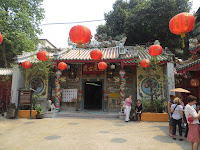 |
| Odean Circle and Royal Jubilee Gate, Chinatown - Bangkok |
 |
Chinese lanterns celebrating the Year of the Snake. |


One can still see little herbal shops dispensing medicines designed to promote "Chi" - achieving balance and harmony within the body. There are also many health food specialty shops, selling fish bladders and bird's nests, among other fascinating items.
 |
| An Herbalist, measuring out a "prescription" |
 |
| A Chinese Pharmacy |
Another enjoyable treat while in Chinatown is to relax by enjoying afternoon tea. This is the Double Dogs Tea House, run by a Chinese tea master.

Wat Traimit is home to the world's largest solid gold Buddha, weighing in at 5.5 tons. It is also home to a fantastic Chinese Heritage Museum which shows the journey of the Chinese immigrants by red-bow junks from China to Thailand.
 The solid gold Buddha was hidden underneath plaster for hundreds of years, it was accidentally discovered in 1955 when the plaster was chipped while the statue was being moved to a new location.
The solid gold Buddha was hidden underneath plaster for hundreds of years, it was accidentally discovered in 1955 when the plaster was chipped while the statue was being moved to a new location.
Thain Fa Foundation Hospital - this hospital was built in 1905 to provide medical care for the Chinese immigrants living in Chinatown, as well as to care for the poor in the neighborhood. There are two sides to the hospital - one side provides western medical care, and the other
provides traditional Chinese medicine.

In 1959, a beautiful statue of Guanyin, the Chinese goddess of Mercy and Compassion was installed inside this pavilion which resembles a Chinese pagoda and is on the grounds of
Thain Fa Hospital. Guanyin is revered throughout Southeast Asia .
Wat Mangkon Kamalawat - the Temple of the Dragon and the Lotus. This is the largest Mahayana Buddhist temple in Thailand and is filled with a huge collection of religious icons and statues of Buddha.
The best way to see Chinatown is to walk up and down the main roads of Yaowarat and Charoen Krung, and the small lanes of Sampheng, Isaranuphap and Tao. The small side strees and lanes are crowded and busy but they are also the best places to get a feel for "Old Chinatown". The best way to get to Chinatown is to exit the water taxi at Ratchawong Pier #5 and walk north on Rachawong Road which intersects with Sampheng Lane, Yaowarat and Charoen Krung Roads.

The other option is to use the MRT subway and get off at Hua Lamphong Train station. The train station is another interesting Bangkok landmark, built by the Dutch before WWI. It is an interesting Art Deco structure, busy with lots of backpackers and Thai's using the mass transit.
At 8 am the National Anthem is played, and everyone in the station stands at attention!










No comments:
Post a Comment